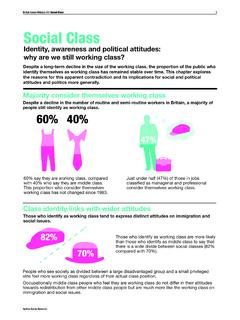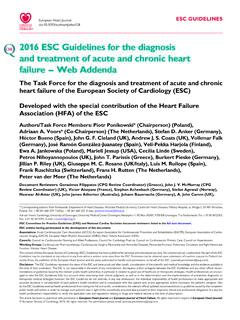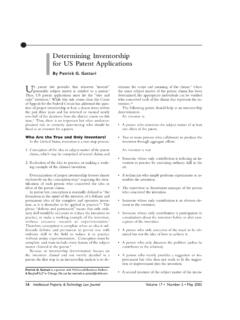Transcription of British Social Attitudes 35 - Gender
1 The National Centre for Social ResearchBritish Social Attitudes 35 | Gender1In this chapter we explore changing Attitudes towards Gender roles in work and at home, as well as views on online sexist bullying and unsolicited comments. We find the British public continues to move away from conservative views of men as breadwinners and women as homemakers, with narrowing divides in views between different demographic and socio-economic groups. Despite this the past five years have seen little change in views of whether mothers should work. Meanwhile there is near consensus in condemning online sexist bullying, and making comments on a woman s appearance in the street is widely seen as Views on Gender roles have become less traditional over the past three decades, including a notable change in Attitudes since New consensus or continuing battleground?Views on traditional Gender roles, 1984-2017 The National Centre for Social ResearchBritish Social Attitudes 35 | Gender2 OverviewTraditional views of Gender roles continue to declineViews on Gender roles continue to become more progressive, and this is particularly true of traditionally conservative groups.
2 72% disagree with the view that a man s job is to earn money; a woman s job is to look after the home and family, up from 58% in 2008. Older people, people with no formal qualifications and people with lower incomes are more likely than other groups to hold traditional Gender role views. But these divisions are narrowing; for example while in 2012 only 30% of people aged 75+ disagreed with this statement, now nearly half do (47%). This corresponds with a a 46 percentage point gap in 2012 between the oldest (75+) and youngest (18-34) age groups, that has now reduced to 27 on working mothersThere is now little public consensus on whether mothers of young children should work or stay at home, representing a shift away from a preference for mothers to stay at home. While a third (33%) say mothers of pre-school children should stay at home, 38% say mothers should work part-time, and 7% full-time.
3 There has been substantial change in this area since 1989, when 64% said mothers of pre-school children should stay at home. But much of this change happened leading up to 2012, and views have remained relatively static over the past five years. Notably a fifth (20%) do not choose an option, up from just 6% in 1989. Comments on a stranger s appearance on the street widely seen as wrongA majority see unsolicited comments towards women as wrong, and there is near consensus against online sexist bullying of women. 57% say it is always or usually wrong for a man to comment on a woman s appearance in the street. This view is more common among men (61%) than women (52%). Fewer (45%) think it is wrong for a woman to comment on a man s appearance in the street, but conversely this view is more common among women (54%) than men (35%). An overwhelming majority (93%) say sexist online bullying towards women is wrong, while 85% say the same about sexist online bullying directed at National Centre for Social ResearchBritish Social Attitudes 35 | Gender3 AuthorsEleanor Attar Taylor, Senior Researcher and Co-Director of the British Social Attitudes series, The National Centre for Social Research Jacqueline Scott,Professor Emerita of Empirical Sociology and Fellow of Queens College, University of CambridgeWomen now represent just under half of the total UK labour forceIntroductionDebates surrounding Gender roles and equality have been a feature of British society since at least the eighteenth century but have gained renewed prominence in British public debate during recent months and years.
4 In February 2018 we celebrated the 100th anniversary of the Representation of the People Act 1918, which gave some women over the age of 30 the right to vote for the first time. December 2018 marks 100 years since the first general election in which women voted in the UK. Such anniversaries, together with other high-profile news events, have focused attention afresh on the roles and experiences of men and women in contemporary society. British society has, in many ways, made substantial progress towards greater Gender equality. More women are in paid employment than ever before: 71% of women aged 16-64 are in paid work, the highest employment rate since records began (Office for National Statistics, 2018). Increasing rates of employment for women are attributed to anti-discrimination legislation (Equal Pay Act, 1970, Sex Discrimination Act and Employment Protection Act, 1975), changes to support for lone parents and the increase in state pension age for women.
5 At the same time, wider changes in the British labour market have seen the growth in services, where women are more likely to work than men, and the decline of the traditionally male-dominated manufacturing sector (Office for National Statistics, 2013). As a result of these changes, including an increase in mothers in work and a decline in male employment, women now represent just under half of the total UK labour men and women now having the same rights under UK law, women still experience significant inequalities in many different areas of life (Baker, 2014). Women with low or no qualifications have much lower employment levels than men with equivalent backgrounds. Women are also more likely than men to be in low paid jobs: 25% of employed women have low pay compared with 15% of employed men (Tinson et. al., 2016). Recently, increasing attention has been paid to the Gender pay gap , with publication for the first time of figures showing the extent of pay differences between men and women in the UK.
6 Analysis of these figures gives a measure of the difference in men s and women s working patterns which underlie disparities in pay: different occupations, part-time roles being predominantly female and the lack of women in senior roles (Jones, 2018). Campaigners maintain that these inequalities are damaging the quality of people s lives, harming relationships, limiting the effectiveness of businesses and institutions and restricting the potential of our children to reach their full potential. Over the last decade, there has also been a marked increase in the public spotlight on issues of behaviour, how men treat women including so called mansplaining (Solnit, 2014) and what is or is not appropriate sexual behaviour. Expos s of sexual harassment have resulted in high profile scandals in media, business, and charity The National Centre for Social ResearchBritish Social Attitudes 35 | Gender4sectors, including resignations of government ministers.
7 The #MeToo Social media campaign, which spread virally in October 2017, helped demonstrate the widespread prevalence of sexual assault and harassment, especially in the workplace. However, what is perceived by some as progress is often met by a backlash from others. Some have claimed that the cultural wars , that have long been part-and-parcel of American civic and political life, have become an increasingly important part of the British Social landscape (Bagehot, 2017). Mary Beard (2017), an academic who was a victim of online abuse, talks of this as the silencing of women, which she claims can be tracked back to ancient civilizations and is still manifest in modern Britain. Opinion seems divided on what the real issues are, and whether responses are proportionate or appropriate. This chapter examines three potential fault lines of Gender politics. First, Attitudes towards Gender roles in the home and in the labour market, including Attitudes towards parental leave.
8 Second, whether there are essential differences between men and women in terms of skills and job suitability. And third, Attitudes to the treatment of women and men, in terms of unsolicited comments in the street and online bullying. Across all these topic areas, the aim is to find out whether there is increasing consensus or an ongoing divergence of opinion. In other words, we want to examine how far the language of culture wars and lines of battle is an appropriate description of how the British public views a range of Gender issues. We also seek to go beyond this to unpack who thinks what across different demographic divides. Existing research suggests that persisting cultural differences are found along key Social stratification divides: Gender , age and class (Esping-Andersen, 2009, Scott et al., 2010). Moreover, these divides remain important even when other relevant factors, including religion, marital status and women s employment are taken into account (Braun and Scott, 2009).
9 Therefore, in order to explore key divides among the British public, we address the following questions: do Attitudes towards Gender politics differ between men and women? If so how and by how much? Is this affected by age? And are there differences according to education and/or income? Gender roles at home and in the labour marketIn this section, we consider three aspects of Attitudes towards men and women s roles in the home and in employment: first, Attitudes to the division of labour, within and outside the home; second, views on mothers employment in different circumstances; and third, how the public thinks a dual earner couple should divide parental leave. The National Centre for Social ResearchBritish Social Attitudes 35 | Gender5 Scott and Clery s (2013) analysis of almost 30 years of British Attitudes to Gender roles, found considerable changes in the way the public viewed the Gender role divide.
10 They predicted that while we might expect to see further reductions in support for a Gender division of labour in subsequent years, the speed of change in Attitudes would slow down. This is because the attitudinal gap between different generations was narrowing, as it became increasingly acceptable and economically necessary for women and mothers to be employed. Here, we extend their analysis by looking particularly at how Attitudes have changed since 2012: have we seen a continuing revolution in Gender role Attitudes or has the pace of change slowed or stalled? And to what extent are British Attitudes in consensus or divided on such important and timely issues? And what are the differences between different groups?During this time, there have been several policy changes aiming to support working families to balance work and childcare. In 2015, Shared Parental Leave was introduced to give greater childcare flexibility for parents in the first year after their baby is born (Department for Business, Innovation and Skills, and Department for Education, 2013).









